Weld Power, Heat Generation and Microstructure in FSW and SFSW of 11Cr-1.6W-1.6Ni Martensitic Stainless Steel: The Impact of Tool Rotation Rate
Abstract
1. Introduction
2. Materials and Methods
3. Results and Discussion
3.1. Tool Plunge Force and Torque
3.2. Welding Power
3.3. Heat Generation
3.4. Macrostructure and Microstructure Analyses
3.5. XRD Analysis
3.6. Hardness Measurements
4. Conclusions
- The plunge force of the tool decreased from 22 kN at 350 rpm to 17 kN at 550 rpm during the FSW process. A similar trend was observed in the plunge force during the SFSW process. However, SFSW requires nearly double the plunge force compared to FSW at the same welding parameters.
- The tool torque decreased, while the weld power increased with the increase in tool rotation rate during both SFSW and FSW processes. However, the required weld power increased by approximately 16% at SFSW compared to FSW to counteract the heat absorption effect of the cooling water.
- Heat generation increased with increasing the tool rotation rate. The heat generated during the SFSW was higher than that produced during the FSW process. At a rotation rate of 550 rpm, the heat generation at SFSW was 130% greater than that at FSW. However, the peak temperatures in the SZs during SFSW were lower than those observed during FSW.
- The parent microstructure in the TMAZ during FSW at elevated temperatures is partially transformed into fine PAGs at rotation rates of 350 and 450 rpm and is fully transformed into fine PAGs at 550 rpm. The phase transformation in the SZ during the FSW process occurred at all tool rotation rates studied. During SFSW, the parent microstructure in both the TMAZ is only deformed without undergoing dynamic recrystallization at 350 rpm and is partially transformed at 450 and 550 rpm. In the SZ at 350 rpm, the parent microstructure is deformed with very little degree of dynamic recrystallization, while partial and full dynamic recrystallization occurred at 450 and 550 rpm, respectively.
- The carbides in BM were dissolved in the SZ resulting in a high carbon content in the martensite matrix. Additionally, the SZ at SFSW exhibited a higher dislocation density and strain rate compared to both the SZ at FSW and BM.
- The average hardness values in the TMAZ and SZ were higher than the BM. Moreover, the hardness values in the SZ during SFSW were higher than those during FSW by about 6 to 7%.
Author Contributions
Funding
Data Availability Statement
Conflicts of Interest
References
- Zhang, H.X.; Chen, W.Y.; Fu, X.Z.; Huang, L.X. Temperature Measurement and Burn Mechanism of Stainless Steel 1Cr11Ni2W2MoV in Grinding. Mater. Sci. Forum 2012, 723, 433–438. [Google Scholar] [CrossRef]
- Kunrong, J.; Zhufeng, Y. Testing study on low cycle fatigue of 1Cr11Ni2W2MoV steel welding joint at middle temperatur. J. Xian Polytech. Univ. 2009, 23, 48–52, (In Chinese with English Abstract). [Google Scholar]
- Wenbo, Z.; Weihua, Y. Research on Welding Technology for 1Cr11Ni2W2MoV Shell of a Starter. J. Rocket Propuls. 2015, 41, 61–67, (In Chinease with English Abstract). [Google Scholar]
- Hong, Y.; Jinxue, W.; Huai, Y.; Guodong, Z. Microstructure and Mechanical Properties of Flash Butt Welded Joints of 1Cr11Ni2W2MoV Stainless Steel after Different Heat Treatment. Electr. Weld. Mach. 2017, 47, 52–54, (In Chinease with English Abstract). [Google Scholar]
- Zhang, C.; Li, M.Q.; Li, H. On the Shear Strength of Similar Diffusion Bonded 1Cr11Ni2W2MoV Stainless Steel Hollow Structural Components: Effect of Void Morphology. J. Manuf. Process. 2017, 29, 10–17. [Google Scholar] [CrossRef]
- Gamil, M.; Farouk, W.M.; Elamy, M.I. Effect of Friction Stir Processing Parameters on the Mechanical and Dynamic Responses of AA5052-H32. Eng. Res. J.—Fac. Eng. 2022, 51, 188–198. [Google Scholar] [CrossRef]
- Boczkal, S.; Mitka, M.; Hrabia-Wiśnios, J.; Płonka, B.; Węglowski, M.S.; Węglowska, A.; Śliwiński, P. Analysis of the Structure and Properties of Welded Joints Made from Aluminum Alloys by Electron Beam Welding (EBW) and Friction Stir Welding (FSW). Crystals 2025, 15, 208. [Google Scholar] [CrossRef]
- Saad, A.; Abdelwanis, S.; Gaafer, A.; Mahmoud, T.; Samir, S. Effect of Friction Stir Welding Processing Parameters on the Mechanical Properties of AA1050 Aluminum Alloy. Eng. Res. J. 2024, 53, 73–79. [Google Scholar] [CrossRef]
- Ragab, M.; Liu, H.; Ahmed, M.M.Z.; Yang, G.-J.; Lou, Z.-J.; Mehboob, G. Microstructure Evolution during Friction Stir Welding of 1Cr11Ni2W2MoV Martensitic Stainless Steel at Different Tool Rotation Rates. Mater. Charact. 2021, 182, 111561. [Google Scholar] [CrossRef]
- Collins, J.; Taylor, M.; Scarlett, A.L.; Palmiere, E.J.; Pickering, E.J. Prior Austenite Grain Measurement: A Direct Comparison of EBSD Reconstruction, Thermal Etching and Chemical Etching. Mater. Charact. 2024, 208, 113656. [Google Scholar] [CrossRef]
- Chikh, A.; Serier, M.; Al-Sabur, R.; Siddiquee, A.N.; Gangil, N. Thermal Modeling of Tool-Work Interface during Friction Stir Welding Process. Russ. J. Non-Ferrous Met. 2022, 63, 690–700. [Google Scholar] [CrossRef]
- Singh, B.; Sharma, S.; Kumar, V.; Maheshwari, K.; Singhal, P. A Review on Heat Generation and Temperature Distribution Models in Friction Stir Welding (FSW). IOP Conf. Ser. Mater. Sci. Eng. 2021, 1116, 012080. [Google Scholar] [CrossRef]
- Minhas, N.; Sharma, V.; Bhadauria, S.S.; Verma, R.; Thakur, A. Evaluating the Effect of Heat Input on Residual Stress, Texture and Corrosion Resistance in Friction-Stir-Welded L-PBF AlSi10Mg Alloy. J. Mater. Sci. 2024, 59, 15830–15858. [Google Scholar] [CrossRef]
- Rathinasuriyan, C.; Muniamuthu, S.; Mystica, A.; Senthil Kumar, V.S. Investigation of Heat Generation during Submerged Friction Stir Welding on 6061-T6 Aluminum Alloy. Mater. Today Proc. 2021, 46, 8320–8324. [Google Scholar] [CrossRef]
- Yaghoubi, M.; Rezaeian, A.; Toroghinejad, M.R.; Mojgani, A.; Gholamalian Dehaghani, H. Effect of Prior Austenite Grain Size on Strength-Ductility Trade-off, Phase Evolution, and Fracture Behavior in a Fully Austenitizated QP Steel: Insights into TRIP Behavior. J. Mater. Res. Technol. 2025, 37, 2434–2448. [Google Scholar] [CrossRef]
- Kalinenko, A.; Vysotskiy, I.; Malopheyev, S.; Mironov, S.; Kaibyshev, R. New Insight into the Phenomenon of the Abnormal Grain Growth in Friction-Stir Welded Aluminum. Mater. Lett. 2021, 302, 130407. [Google Scholar] [CrossRef]
- Ge, X.; Kolupaev, I.N.; Jiang, D.; Song, W.; Wang, H. Influence of Rotational Speed on the Microstructure and Mechanical Properties of Refill Friction Stir Spot Welded Pure Copper. Crystals 2025, 15, 268. [Google Scholar] [CrossRef]
- Meyghani, B.; Awang, M. The Influence of the Tool Tilt Angle on the Heat Generation and the Material Behavior in Friction Stir Welding (FSW). Metals 2022, 12, 1837. [Google Scholar] [CrossRef]
- Kim, J.H.; Choi, H.N.; Lee, K.J.; Shin, J.h.; Seo, N.h.; Jung, J.G.; Lee, S.J.; Lee, S.J. Effect of Welding Speed on Microstructural Evolution and Strengthening Mechanism of Friction-Stir Welded 7075 Aluminum. Mater. Sci. Eng. A 2024, 908, 146695. [Google Scholar] [CrossRef]
- Ni, Y.; Fu, L.; Chen, H.Y. Effects of Travel Speed on Mechanical Properties of AA7075-T6 Ultra-Thin Sheet Joints Fabricated by High Rotational Speed Micro Pinless Friction Stir Welding. J. Mater. Process. Technol. 2019, 265, 63–70. [Google Scholar] [CrossRef]
- Mishra, R.S.; Ma, Z.Y. Friction Stir Welding and Processing. Mater. Sci. Eng. R Rep. 2005, 50, 1–78. [Google Scholar] [CrossRef]
- Ragab, M.; Liu, H.; Abdel-Aleem, H.A.; El-Sayed Seleman, M.M.; Ahmed, M.M.Z.; Mehboob, G. Numerical and Experimental Study of Underwater Friction Stir Welding of 1Cr11Ni2W2MoV Heat-Resistant Stainless Steel. J. Mater. Res. Technol. 2024, 29, 130–148. [Google Scholar] [CrossRef]
- Mugada, K.K.; Adepu, K. Role of Tool Shoulder End Features on Friction Stir Weld Characteristics of 6082 Aluminum Alloy. J. Inst. Eng. Ser. C 2019, 100, 343–350. [Google Scholar] [CrossRef]
- Ragab, M.; Liu, H.; Yang, G.-J.; Ahmed, M.M.Z. Friction Stir Welding of 1Cr11Ni2W2MoV Martensitic Stainless Steel: Numerical Simulation Based on Coupled Eulerian Lagrangian Approach Supported with Experimental Work. Appl. Sci. 2021, 11, 3049. [Google Scholar] [CrossRef]
- Iqbal, M.P.; Vishwakarma, R.K.; Pal, S.K.; Mandal, P. Influence of Plunge Depth during Friction Stir Welding of Aluminum Pipes. Proc. Inst. Mech. Eng. Part B J. Eng. Manuf. 2023, 237, 2085–2096. [Google Scholar] [CrossRef]
- Kumar, S.; Triveni, M.K.; Katiyar, J.K.; Tiwari, T.N.; Roy, B.S. Prediction of Heat Generation Effect on Force Torque and Mechanical Properties at Varying Tool Rotational Speed in Friction Stir Welding Using Artificial Neural Network. Proc. Inst. Mech. Eng. Part C J. Mech. Eng. Sci. 2023, 237, 4495–4514. [Google Scholar] [CrossRef]
- Aghajani Derazkola, H.; Kordani, N.; Aghajani Derazkola, H. Effects of Friction Stir Welding Tool Tilt Angle on Properties of Al-Mg-Si Alloy T-Joint. CIRP J. Manuf. Sci. Technol. 2021, 33, 264–276. [Google Scholar] [CrossRef]
- Rajakrishnan, N.; Sadeghifar, M.; Bhattacharjee, P.; Champliaud, H.; Jahazi, M. Kinetics of Austenite Formation in a Medium-Carbon, Low-Alloy Steel with an Initial Martensite Microstructure: Influence of Prior Austenite Grain Size. J. Manuf. Mater. Process. 2025, 9, 10. [Google Scholar] [CrossRef]
- Barrick, E.J.; Dupont, J.N. Materials Science & Engineering A The Influence of Martensitic Microstructure and Oxide Inclusions on the Toughness of Simulated Reheated 10 Wt % Ni Steel Weld Metal Multi-Pass Fusion Zones. Mater. Sci. Eng. A 2021, 801, 140336. [Google Scholar] [CrossRef]
- Venugopal, V.; Pratap Singh, V.; Kuriachen, B. Underwater Friction Stir Welding of Marine Grade Aluminium Alloys: A Review. Mater. Today Proc. 2023, 4–8. [Google Scholar] [CrossRef]
- Elshaghoul, Y.G.Y.; El-Sayed Seleman, M.M.; Bakkar, A.; Elnekhaily, S.A.; Albaijan, I.; Ahmed, M.M.Z.; Abdel-Samad, A.; Reda, R. Additive Friction Stir Deposition of AA7075-T6 Alloy: Impact of Process Parameters on the Microstructures and Properties of the Continuously Deposited Multilayered Parts. Appl. Sci. 2023, 13, 10255. [Google Scholar] [CrossRef]
- Lader, S.K.; Baruah, M.; Ballav, R. Experimental Investigation of Al 2024 Aluminum Alloy Joints by Underwater Friction Stir Welding for Different Tool Pin Profile BT—Next Generation Materials and Processing Technologies. In Proceedings of the Next Generation Materials and Processing Technologies, RDMPMC 2020, Jamshedpur, India, 26–27 August 2020; Bag, S., Paul, C.P., Baruah, M., Eds.; Springer Singapore: Singapore, 2021; pp. 81–97. [Google Scholar] [CrossRef]
- Shi, L.; Wu, C.S.; Liu, H.J. The Effect of the Welding Parameters and Tool Size on the Thermal Process and Tool Torque in Reverse Dual-Rotation Friction Stir Welding. Int. J. Mach. Tools Manuf. 2015, 91, 1–11. [Google Scholar] [CrossRef]
- Choi, W.J.; Morrow, J.D.; Pfefferkorn, F.E.; Zinn, M.R. Welding Parameter Maps to Help Select Power and Energy Consumption of Friction Stir Welding. J. Manuf. Process. 2018, 33, 35–42. [Google Scholar] [CrossRef]
- Pouraliakbar, H.; Aval, H.J.; Howells, A.; Gallerneault, M.; Fallah, V. Microstructural Evolution and Mechanical Properties of Rapidly Solidified Thin-Strip Continuous Cast AA5182 Al-Mg Alloy under Varying Heat Inputs in Friction Stir Welding. Int. J. Adv. Manuf. Technol. 2023, 129, 2921–2931. [Google Scholar] [CrossRef]
- El-Hafez, H.A. Mechanical Properties and Welding Power of Friction Stirred AA2024-T35 Joints. J. Mater. Eng. Perform. 2011, 20, 839–845. [Google Scholar] [CrossRef]
- Abhilash; Nunthavarawong, P.; Ratanathavorn, W.; Kowitwarangkul, P.; Narayanasamy, P.; Dohda, K. Thermal Simulation: Heat Input Impact on Joint Temperatures in Aluminum-Steel Friction Stir Lap Joints. J. Mater. Eng. Perform. 2025. [Google Scholar] [CrossRef]
- Li, J.S.; Cheng, G.J.; Yen, H.W.; Yang, Y.L.; Chang, H.Y.; Wu, C.Y.; Wang, S.H.; Yang, J.R. Microstrain and Boundary Misorientation Evolution for Recrystallized Super DSS after Deformation. Mater. Chem. Phys. 2020, 246, 122815. [Google Scholar] [CrossRef]
- Zhang, X.X.; Andrä, H.; Harjo, S.; Gong, W.; Kawasaki, T.; Lutz, A.; Lahres, M. Quantifying Internal Strains, Stresses, and Dislocation Density in Additively Manufactured AlSi10Mg during Loading-Unloading-Reloading Deformation. Mater. Des. 2021, 198, 109339. [Google Scholar] [CrossRef]
- Fujiyama, K.; Mori, K.; Matsunaga, T.; Kimachi, H.; Saito, T.; Hino, T.; Ishii, R. Creep-Damage Assessment of High Chromium Heat Resistant Steels and Weldments. Mater. Sci. Eng. A 2009, 511, 195–201. [Google Scholar] [CrossRef]
- Cui, C.; Dong, J.; Epp, J.; Schulz, A.; Steinbacher, M.; Acar, S.; Herbst, S.; Maier, H.J. In Situ X-Ray Diffraction Analysis of Microstructure Evolution during Deep Cryogenic Treatment and Tempering of Tool Steels. Steel Res. Int. 2021, 92, 2100076. [Google Scholar] [CrossRef]
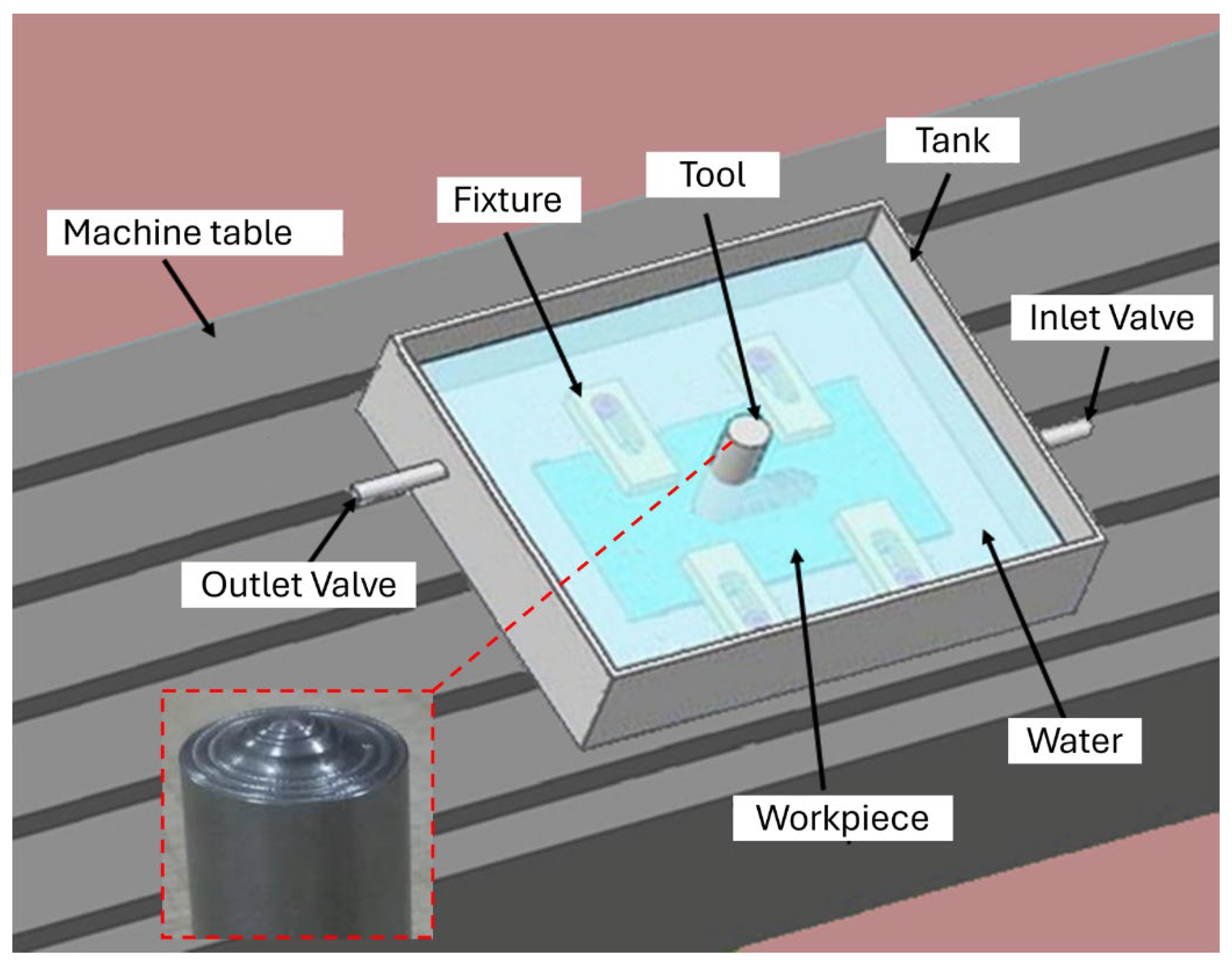
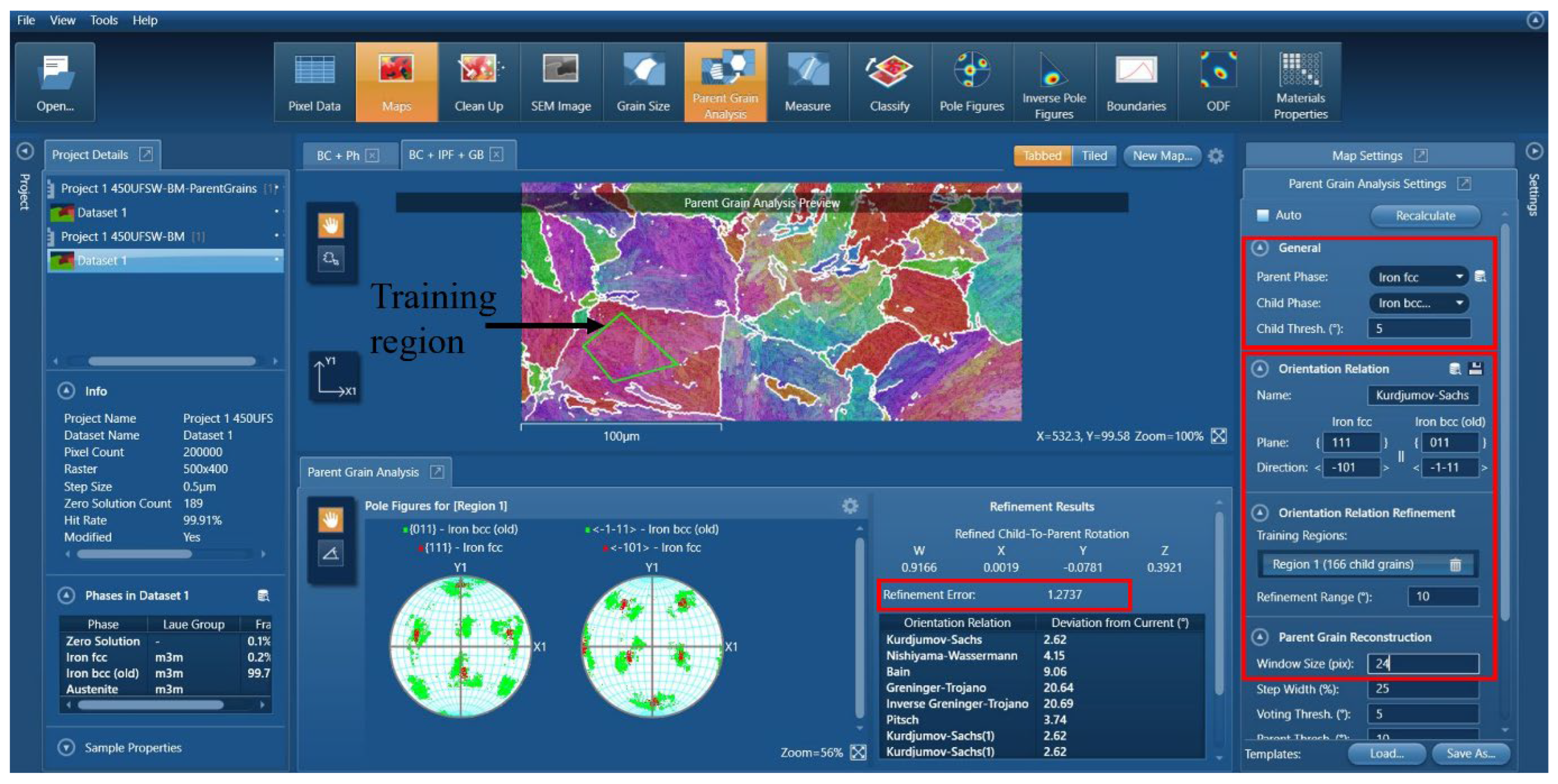
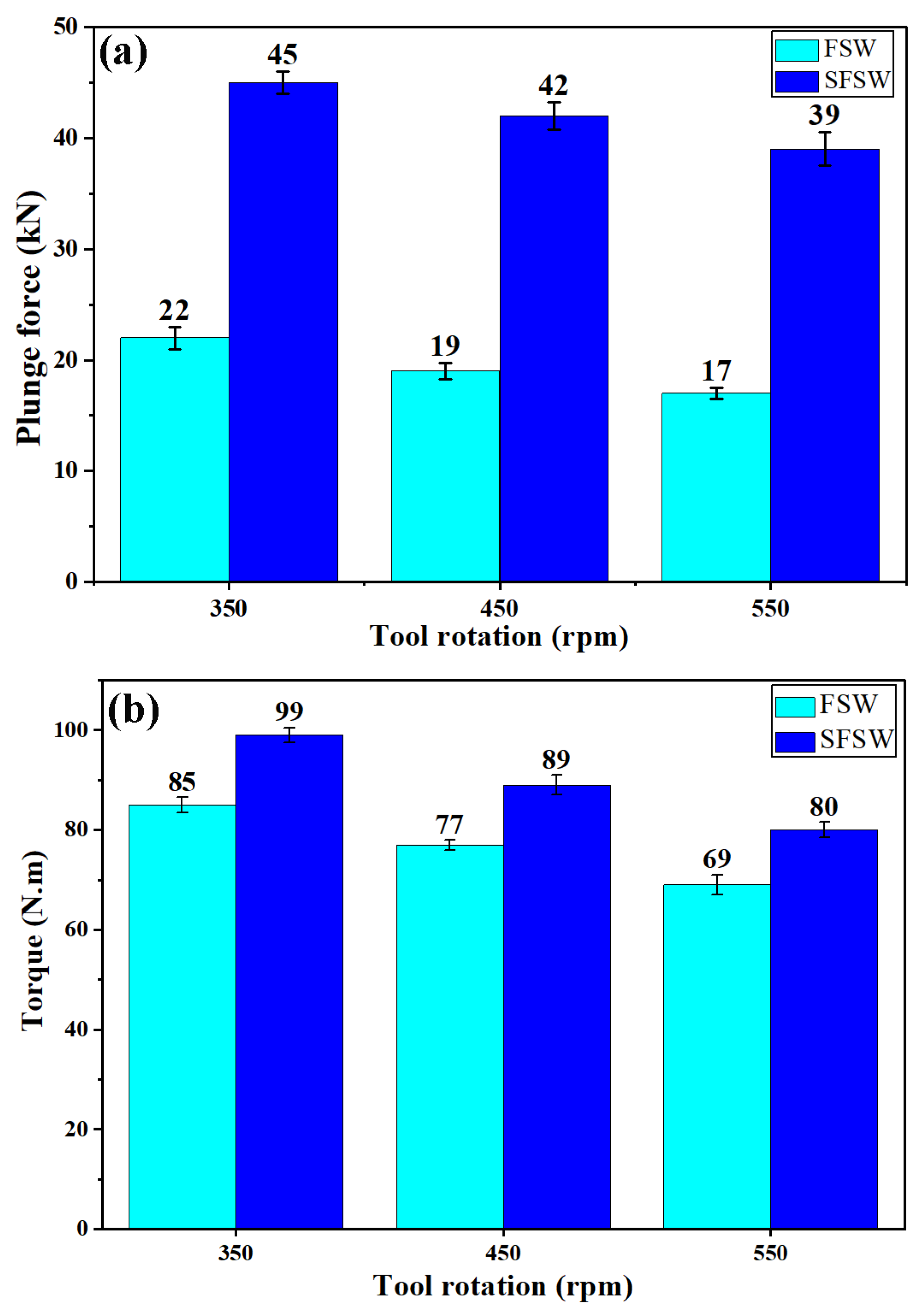
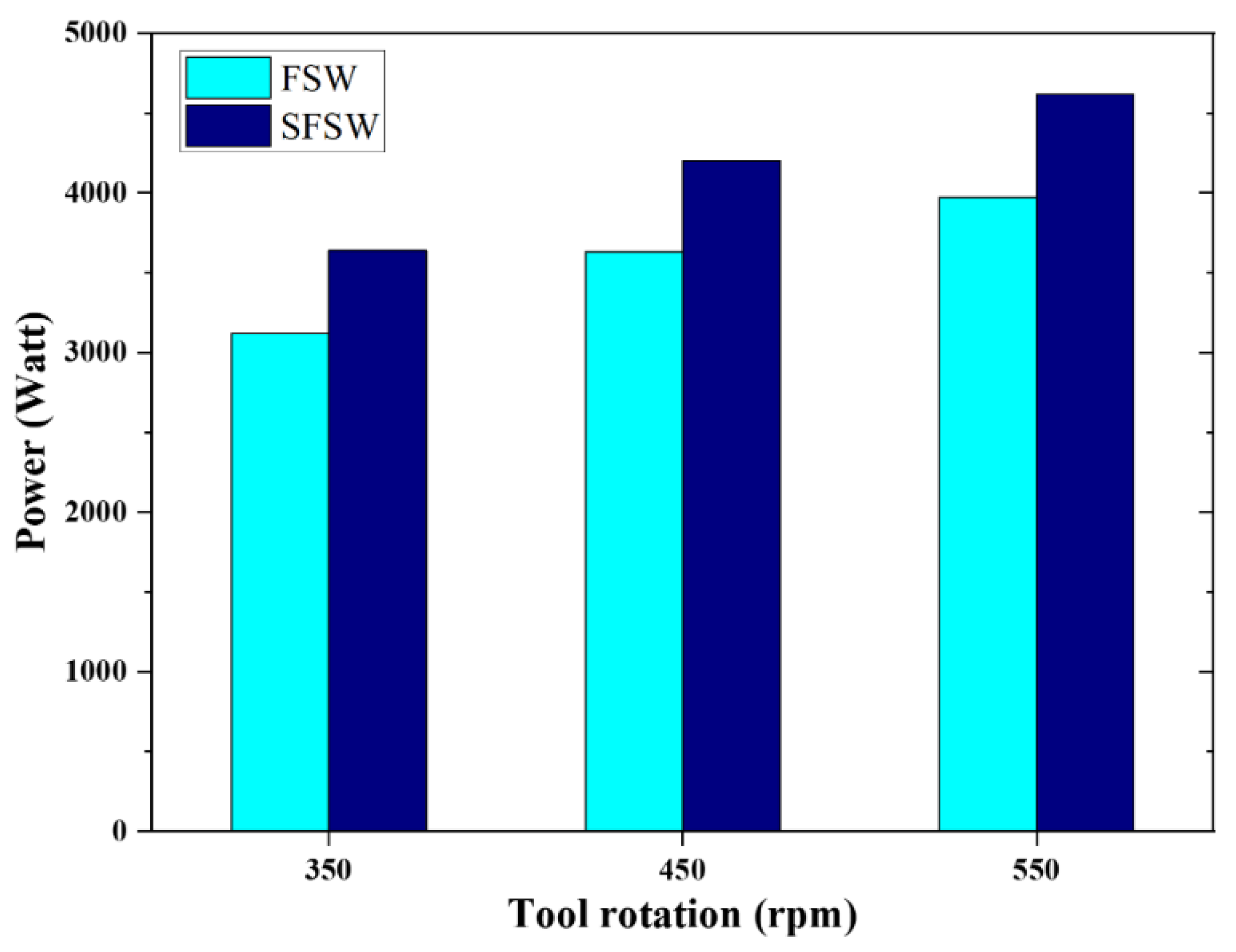
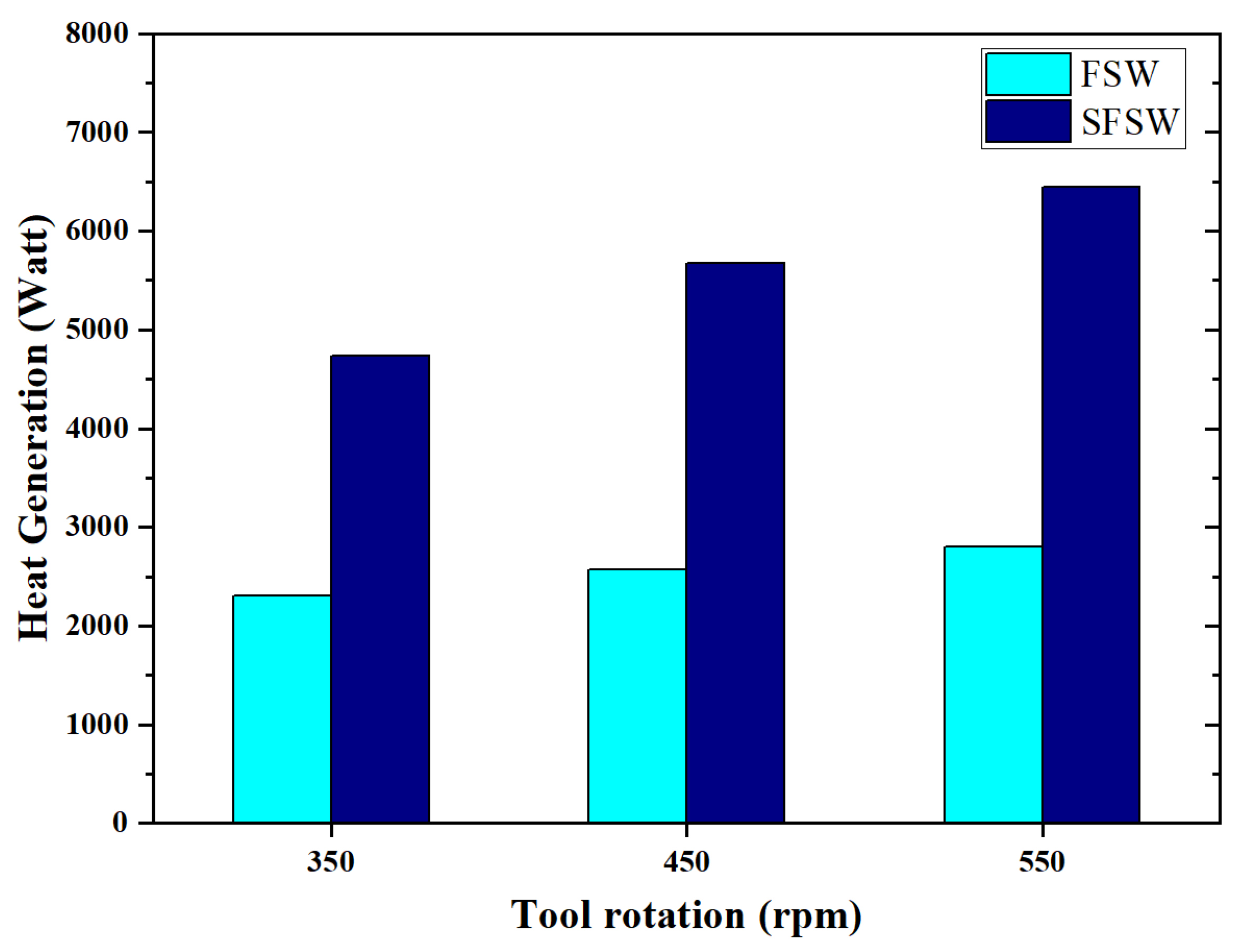
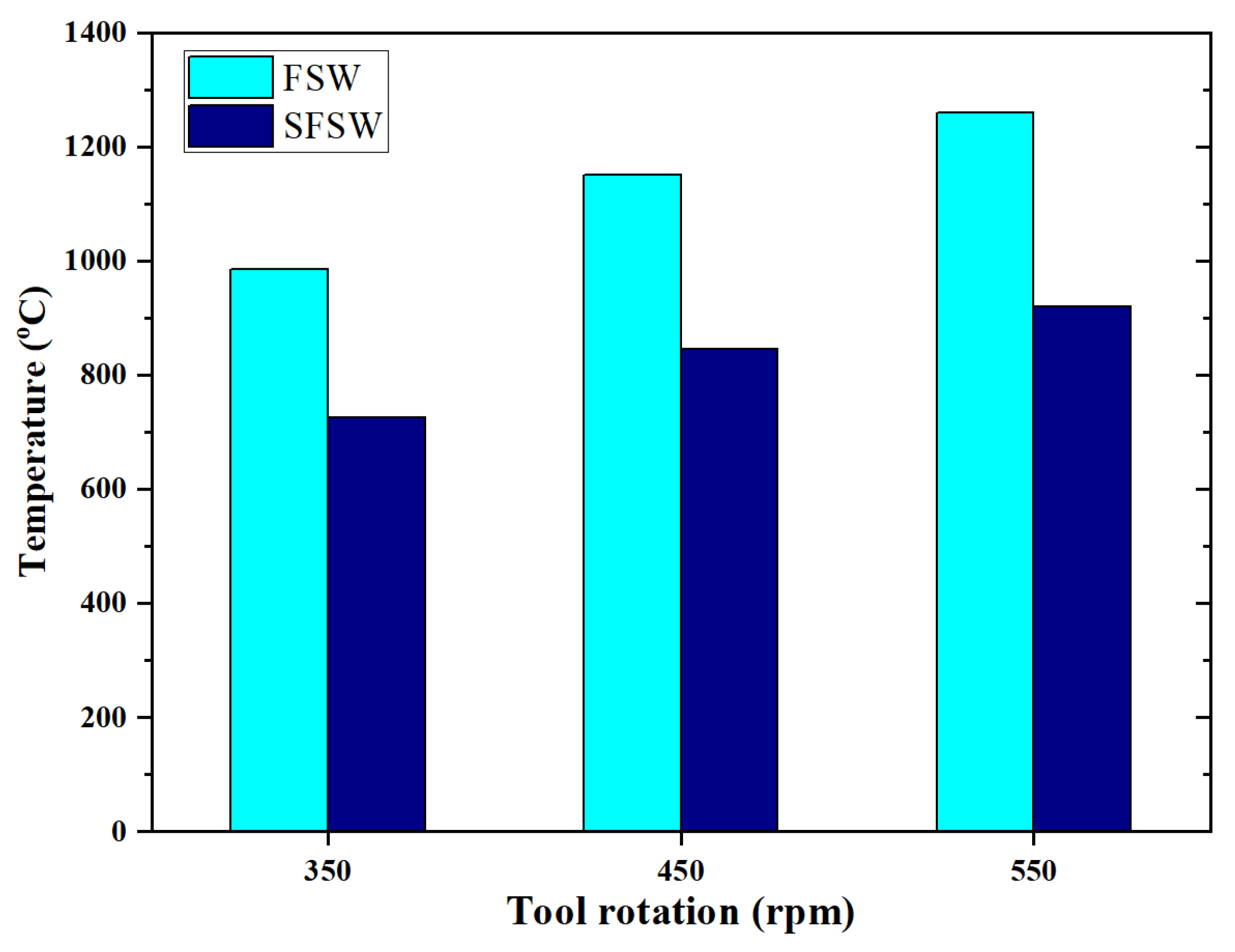
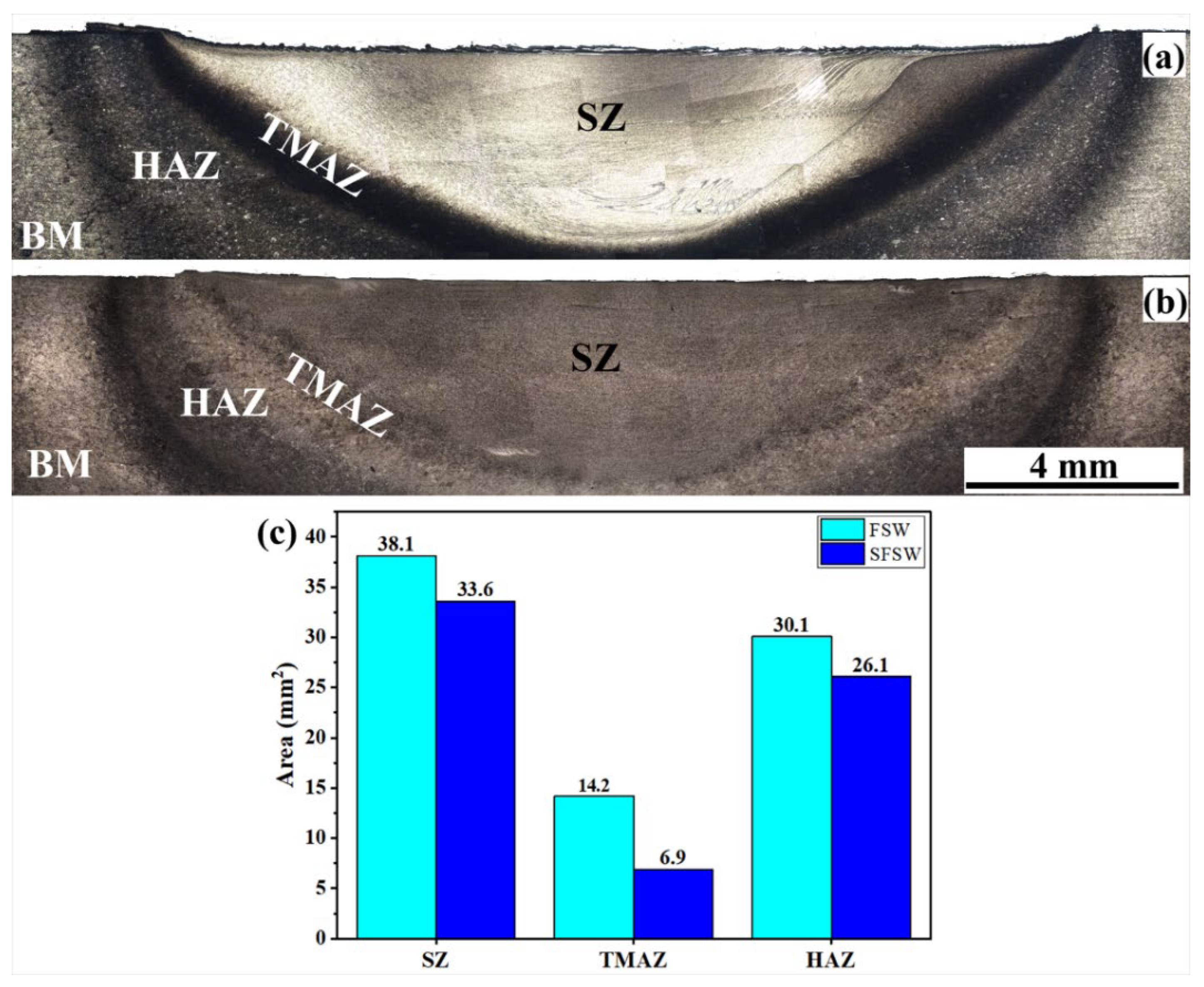
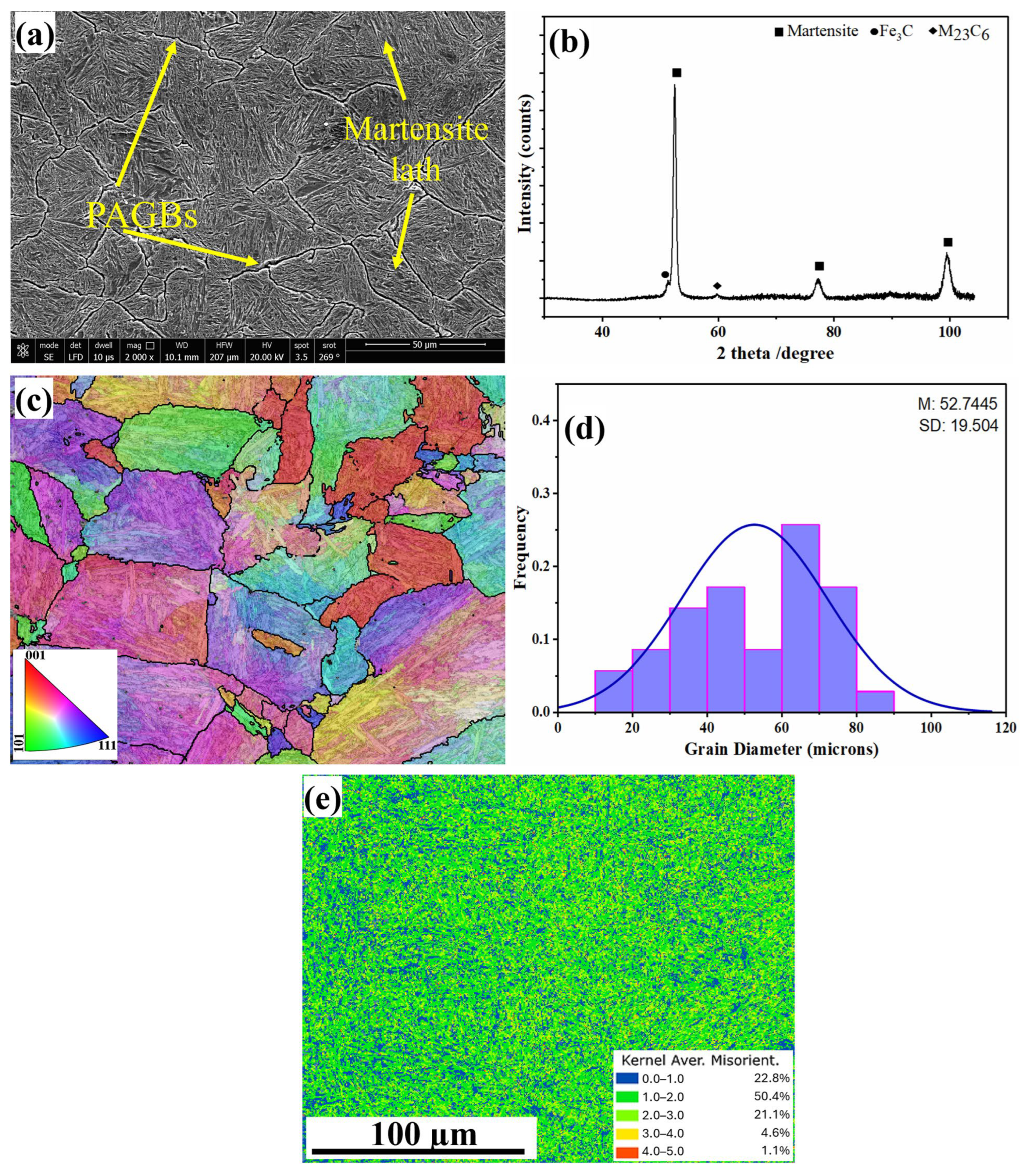
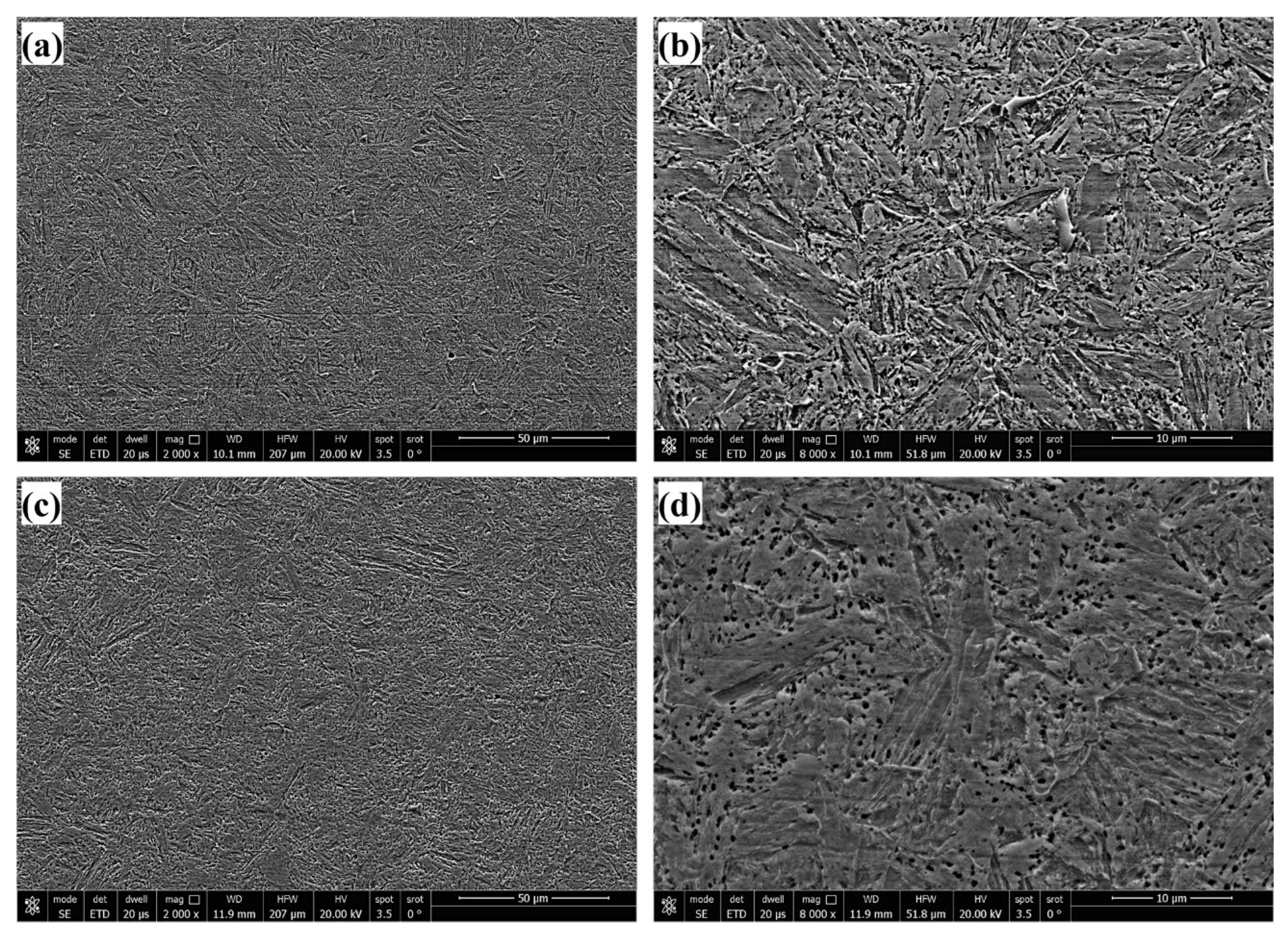
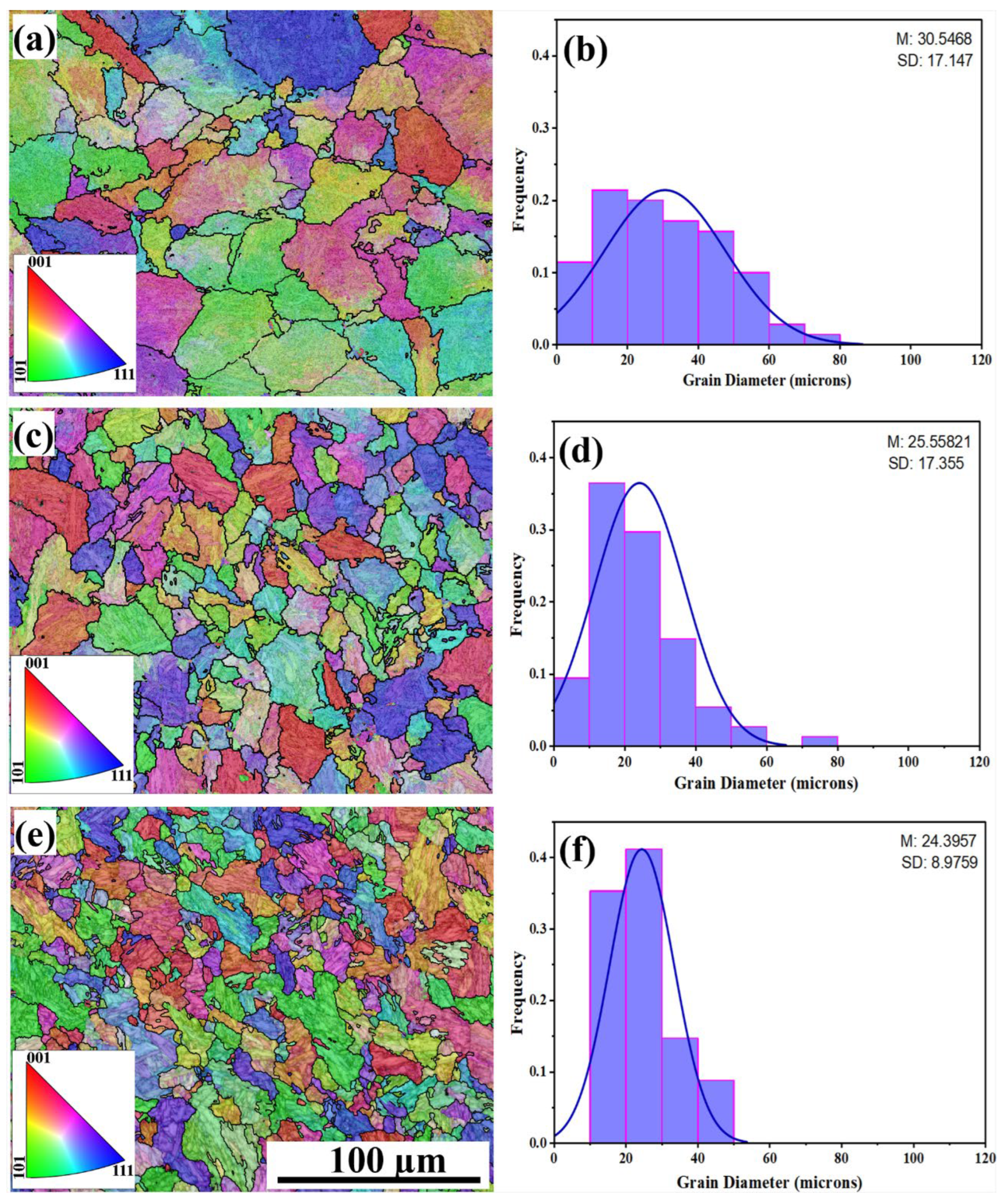
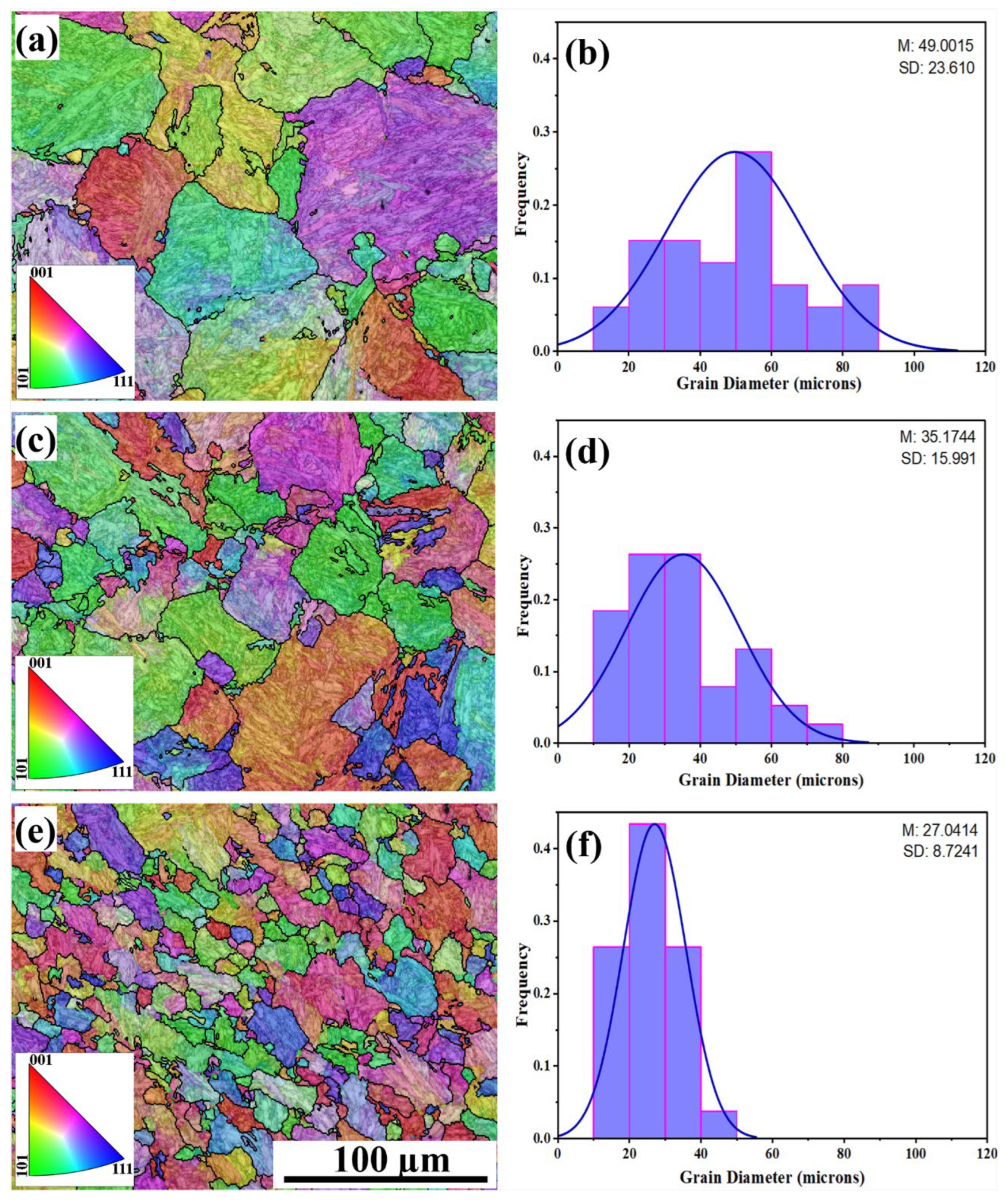
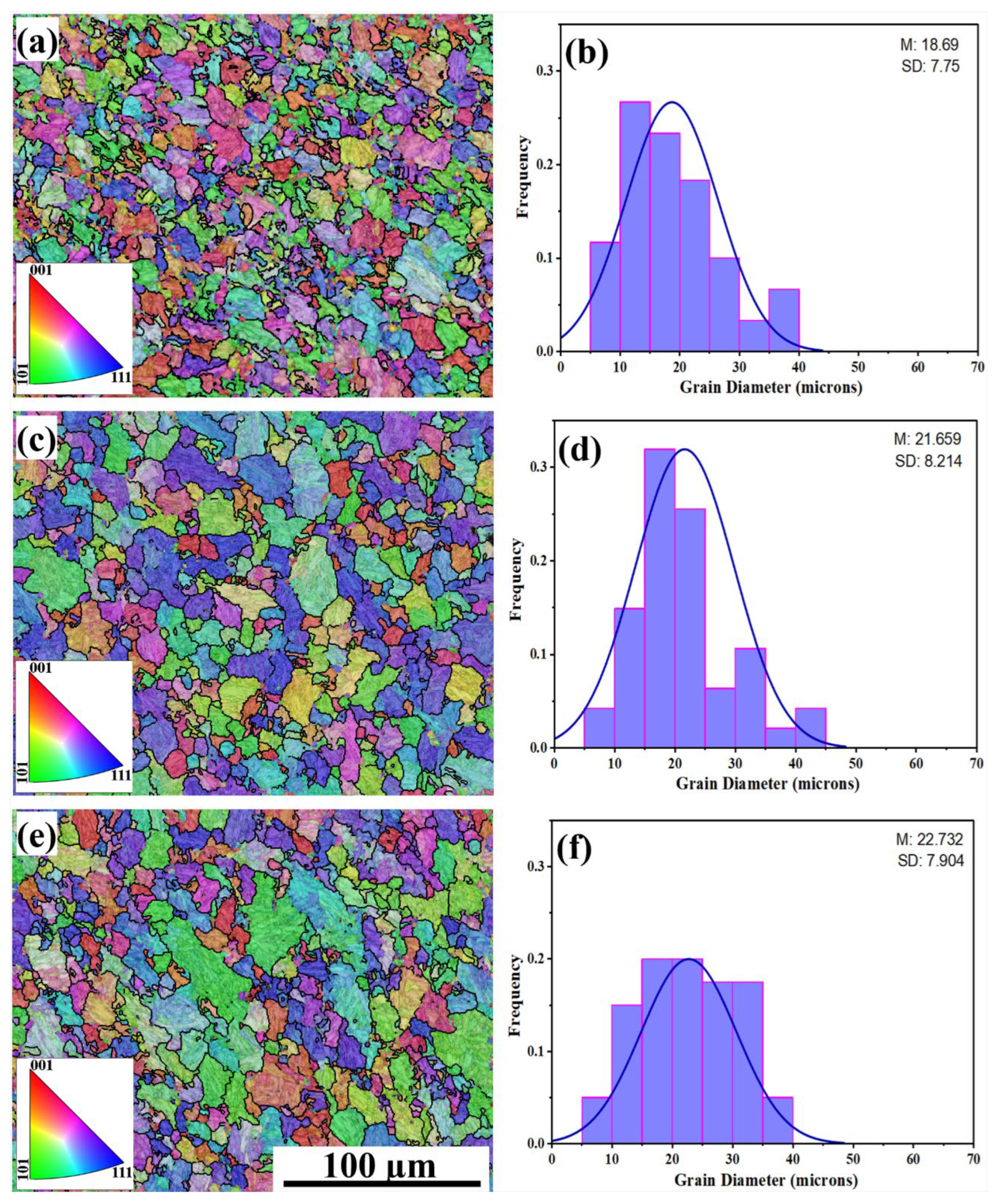
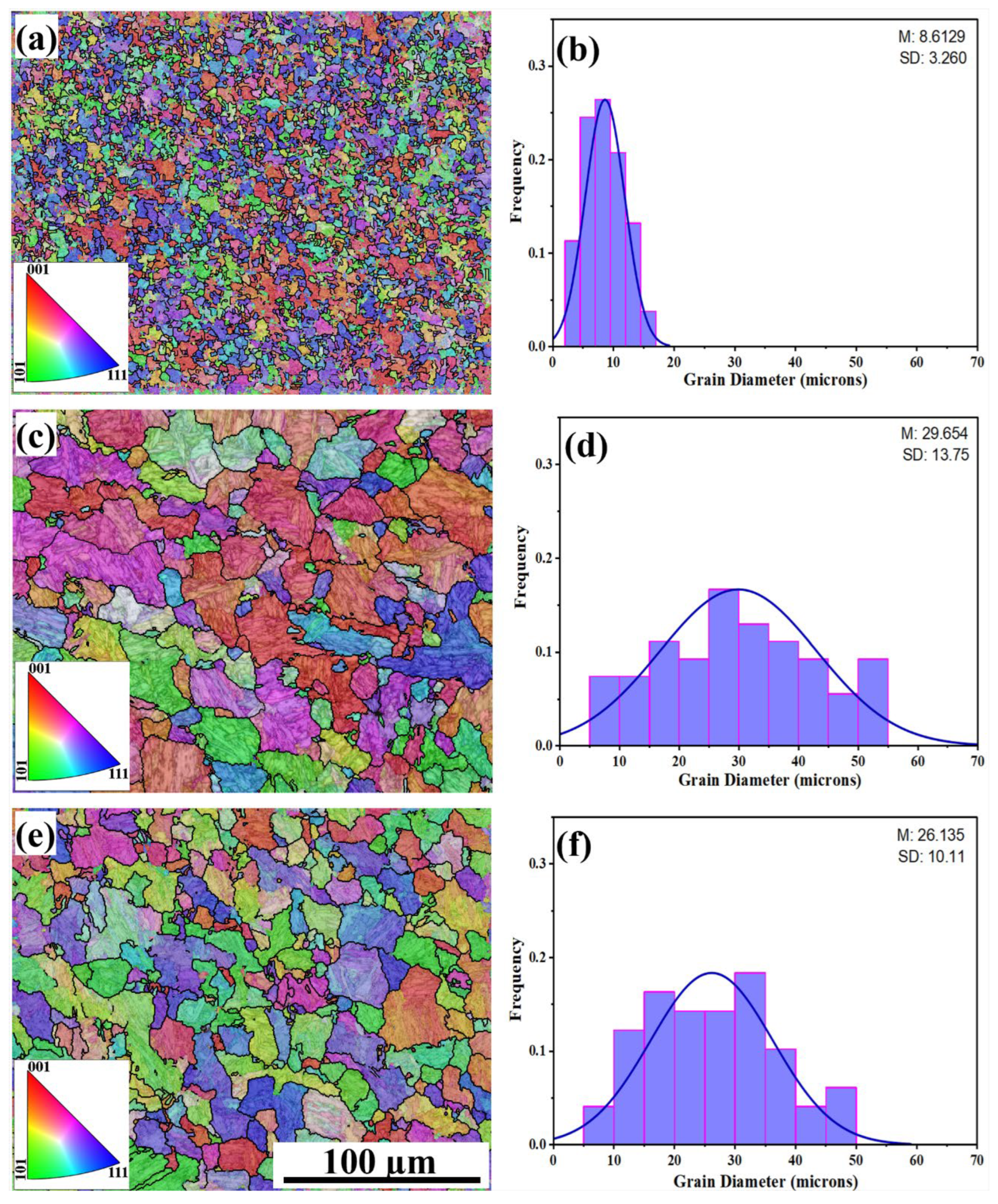
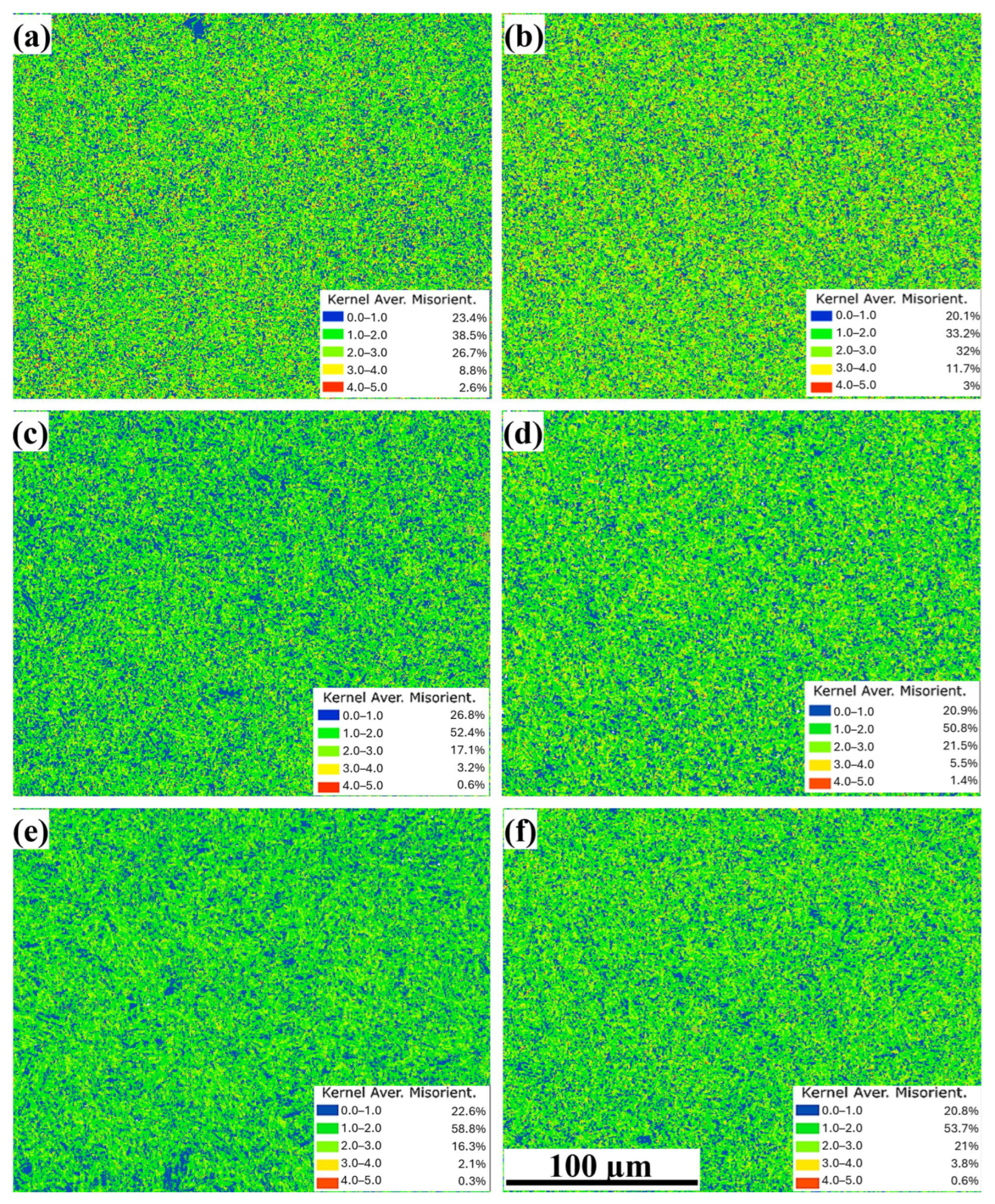
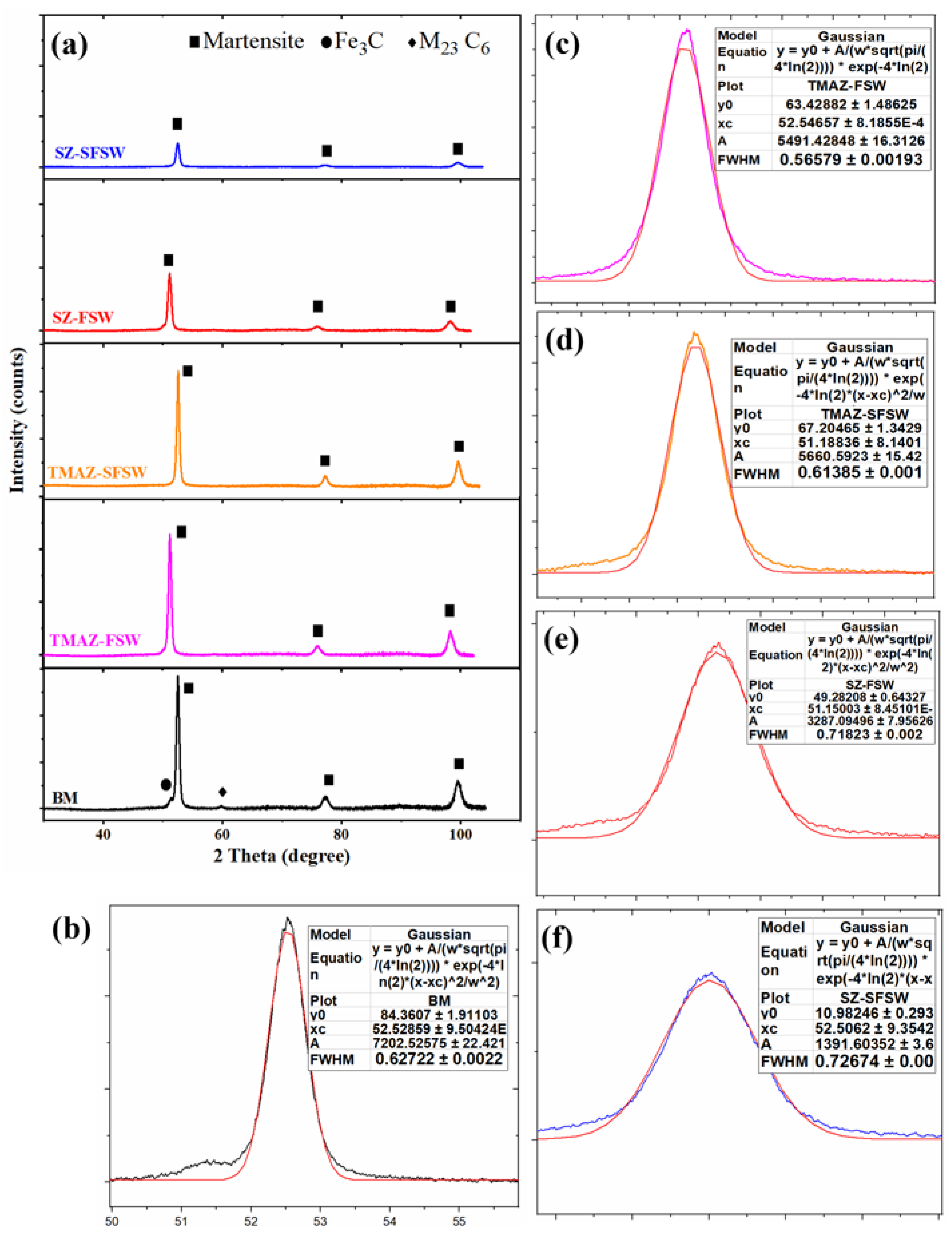

| % | C | Si | Mn | P | S | Ni | Cr | Mo | W | V | Fe |
|---|---|---|---|---|---|---|---|---|---|---|---|
| Min. | 0.1 | - | - | - | - | 1.4 | 10.5 | 0.3 | 1.5 | 0.18 | - |
| Max. | 0.16 | 0.6 | 0.6 | 0.035 | 0.035 | 1.8 | 12 | 0.5 | 2 | 0.3 | Bal. |
| 350 rpm | 450 rpm | 550 rpm | ||||
|---|---|---|---|---|---|---|
| FSW | SFSW | FSW | SFSW | FSW | SFSW | |
| TMAZ | 31 | 49 | 26 | 35 | 24 | 27 |
| SZ | 19 | 9 | 22 | 30 | 23 | 26 |
| Condition | BM | 350 rpm | 450 rpm | 550 rpm |
|---|---|---|---|---|
| FSW | 1.61 | 1.787 | 1.487 | 1.488 |
| SFSW | 1.943 | 1.659 | 1.584 |
Disclaimer/Publisher’s Note: The statements, opinions and data contained in all publications are solely those of the individual author(s) and contributor(s) and not of MDPI and/or the editor(s). MDPI and/or the editor(s) disclaim responsibility for any injury to people or property resulting from any ideas, methods, instructions or products referred to in the content. |
© 2025 by the authors. Licensee MDPI, Basel, Switzerland. This article is an open access article distributed under the terms and conditions of the Creative Commons Attribution (CC BY) license (https://creativecommons.org/licenses/by/4.0/).
Share and Cite
Ragab, M.; Alsaleh, N.; El-Sayed Seleman, M.M.; Ahmed, M.M.Z.; Ataya, S.; Elshaghoul, Y.G.Y. Weld Power, Heat Generation and Microstructure in FSW and SFSW of 11Cr-1.6W-1.6Ni Martensitic Stainless Steel: The Impact of Tool Rotation Rate. Crystals 2025, 15, 845. https://doi.org/10.3390/cryst15100845
Ragab M, Alsaleh N, El-Sayed Seleman MM, Ahmed MMZ, Ataya S, Elshaghoul YGY. Weld Power, Heat Generation and Microstructure in FSW and SFSW of 11Cr-1.6W-1.6Ni Martensitic Stainless Steel: The Impact of Tool Rotation Rate. Crystals. 2025; 15(10):845. https://doi.org/10.3390/cryst15100845
Chicago/Turabian StyleRagab, Mohamed, Naser Alsaleh, Mohamed M. El-Sayed Seleman, Mohamed M. Z. Ahmed, Sabbah Ataya, and Yousef G. Y. Elshaghoul. 2025. "Weld Power, Heat Generation and Microstructure in FSW and SFSW of 11Cr-1.6W-1.6Ni Martensitic Stainless Steel: The Impact of Tool Rotation Rate" Crystals 15, no. 10: 845. https://doi.org/10.3390/cryst15100845
APA StyleRagab, M., Alsaleh, N., El-Sayed Seleman, M. M., Ahmed, M. M. Z., Ataya, S., & Elshaghoul, Y. G. Y. (2025). Weld Power, Heat Generation and Microstructure in FSW and SFSW of 11Cr-1.6W-1.6Ni Martensitic Stainless Steel: The Impact of Tool Rotation Rate. Crystals, 15(10), 845. https://doi.org/10.3390/cryst15100845











